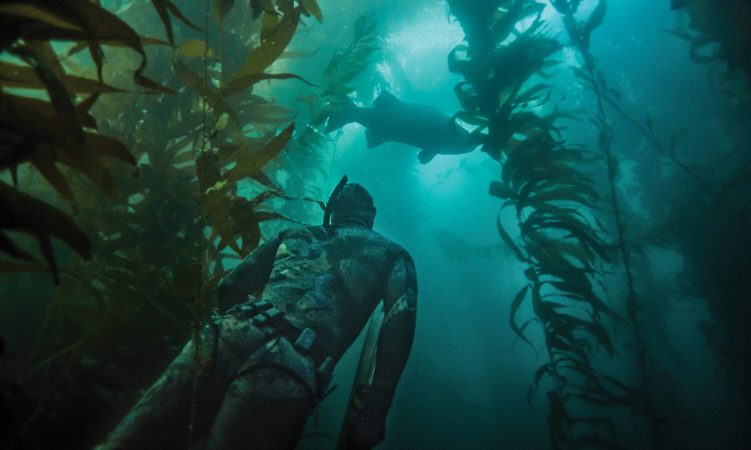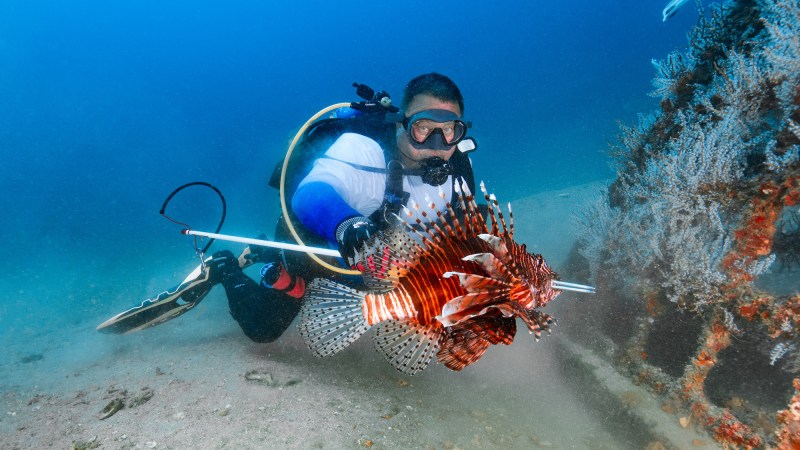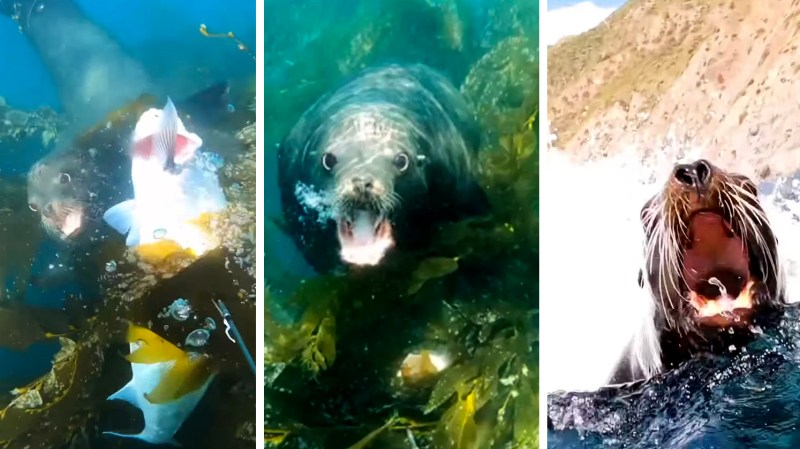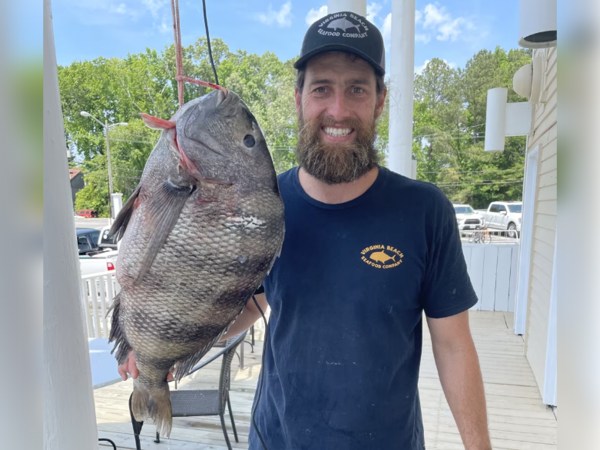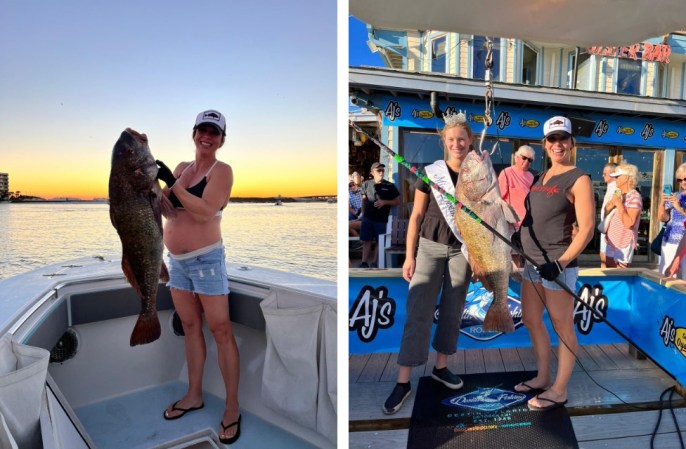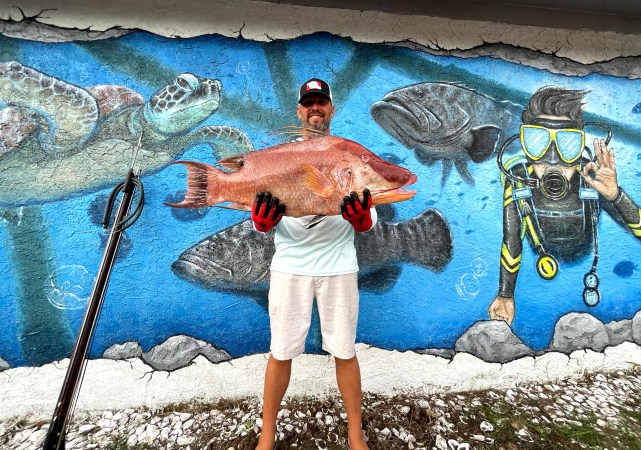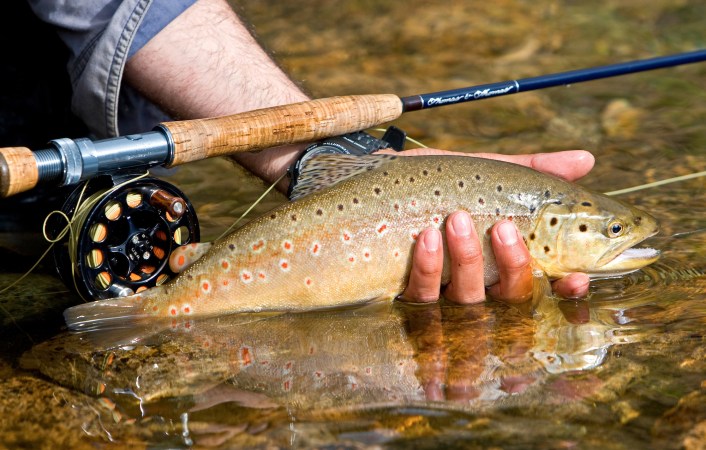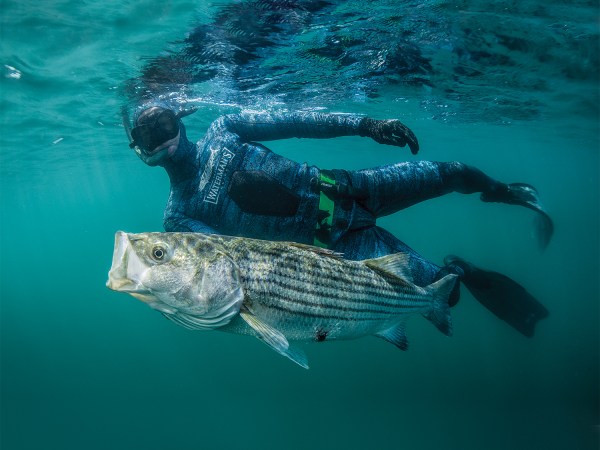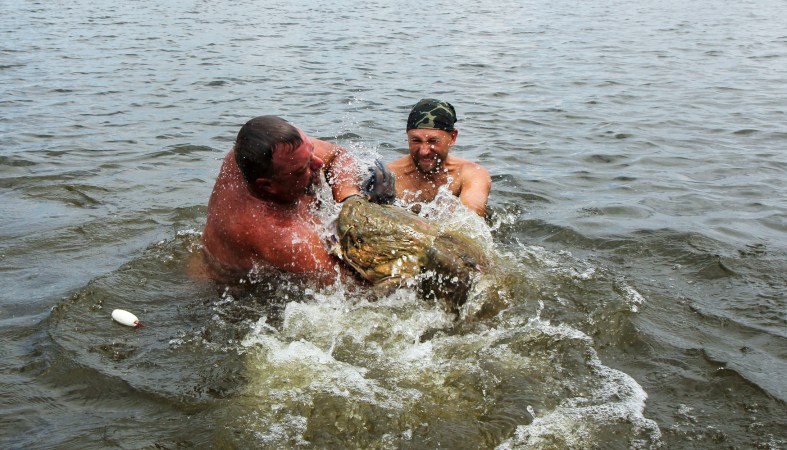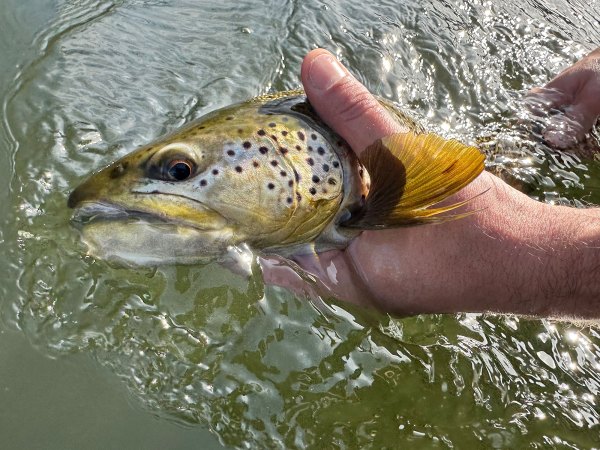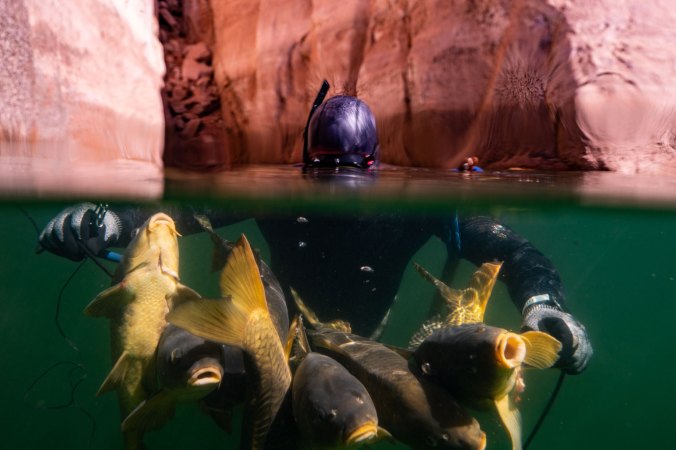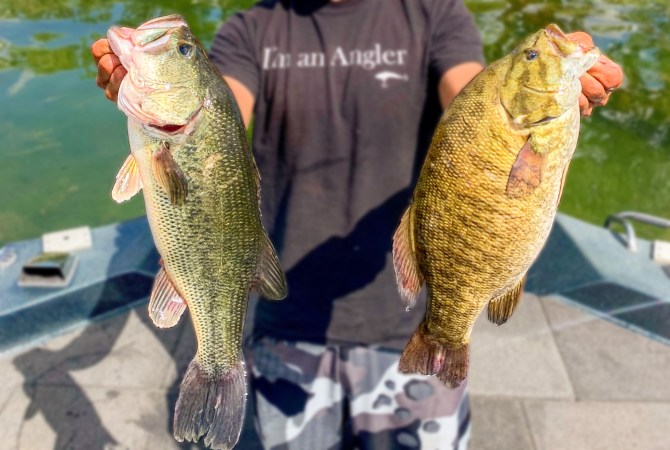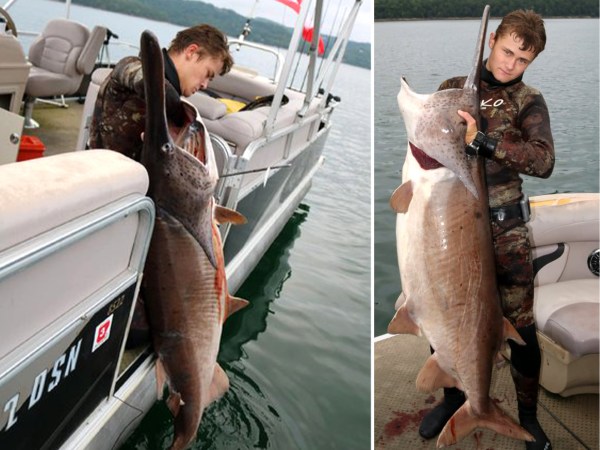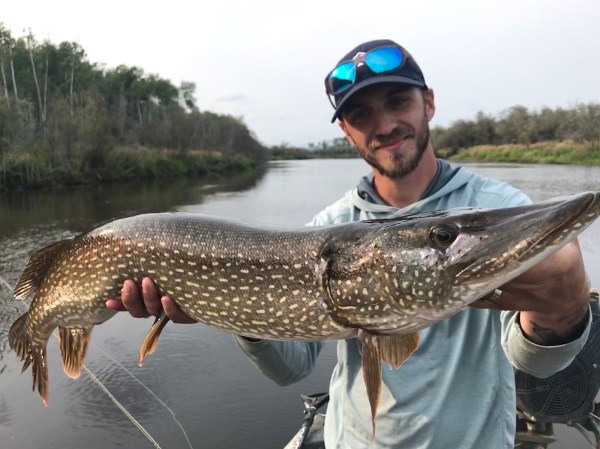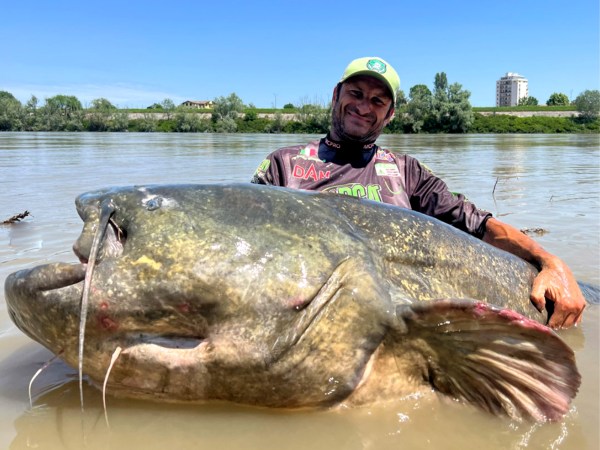We may earn revenue from the products available on this page and participate in affiliate programs. Learn More ›
Spearfishing is the ideal intersection of hunting and fishing. Instead of waiting for fish to bite, you’re tapping into your stealth, your hand-eye coordination, and your instincts to survive underwater. Once you shoot a fish, you must ensure you don’t get tangled in your line, you don’t lose the fish, and you don’t run out of air before returning to the surface — all in a matter of minutes.
And, as with any kind of fishing, there are dozens of ways to spearfish. You can snorkel for walleye in the Great Lakes, skewer invasive fish in Texas’ spring-fed San Marcos River, freedive in a shark-infested kelp paddy 20 miles off the coast of Mexico, and most anything in between. Beginners can easily get into spearfishing and find success with minimal training; the most hardcore spearfishermen spend a lifetime chasing fish and honing their skills.
Spearfishing Topics in This Article
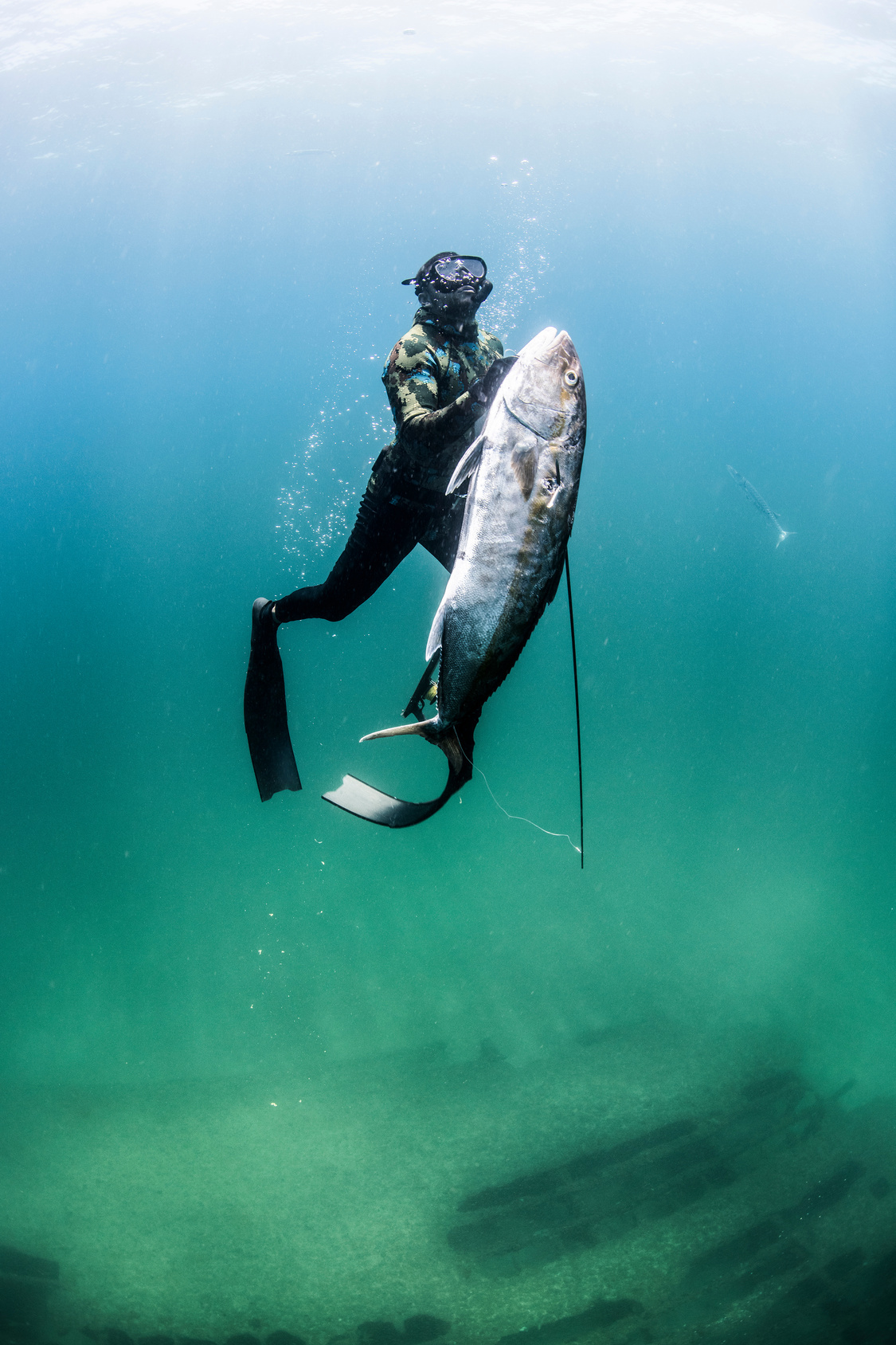
Read through the article in chronological order, or click on any topic to jump to it:
- How to Use This Spearfishing Guide
- Spearfishing Basics
- Gear You’ll Need
- Types of Spearguns
- Intro to Freediving
- Spearfishing from the Surface
- Locating Fish for Spearfishing
- Spearfishing Techniques
- Recovering and Caring for Fish
- Is Spearfishing Dangerous?
- Scuba Diving and Spearfishing
- FAQs
- Final Thoughts
How to Use This Spearfishing Guide
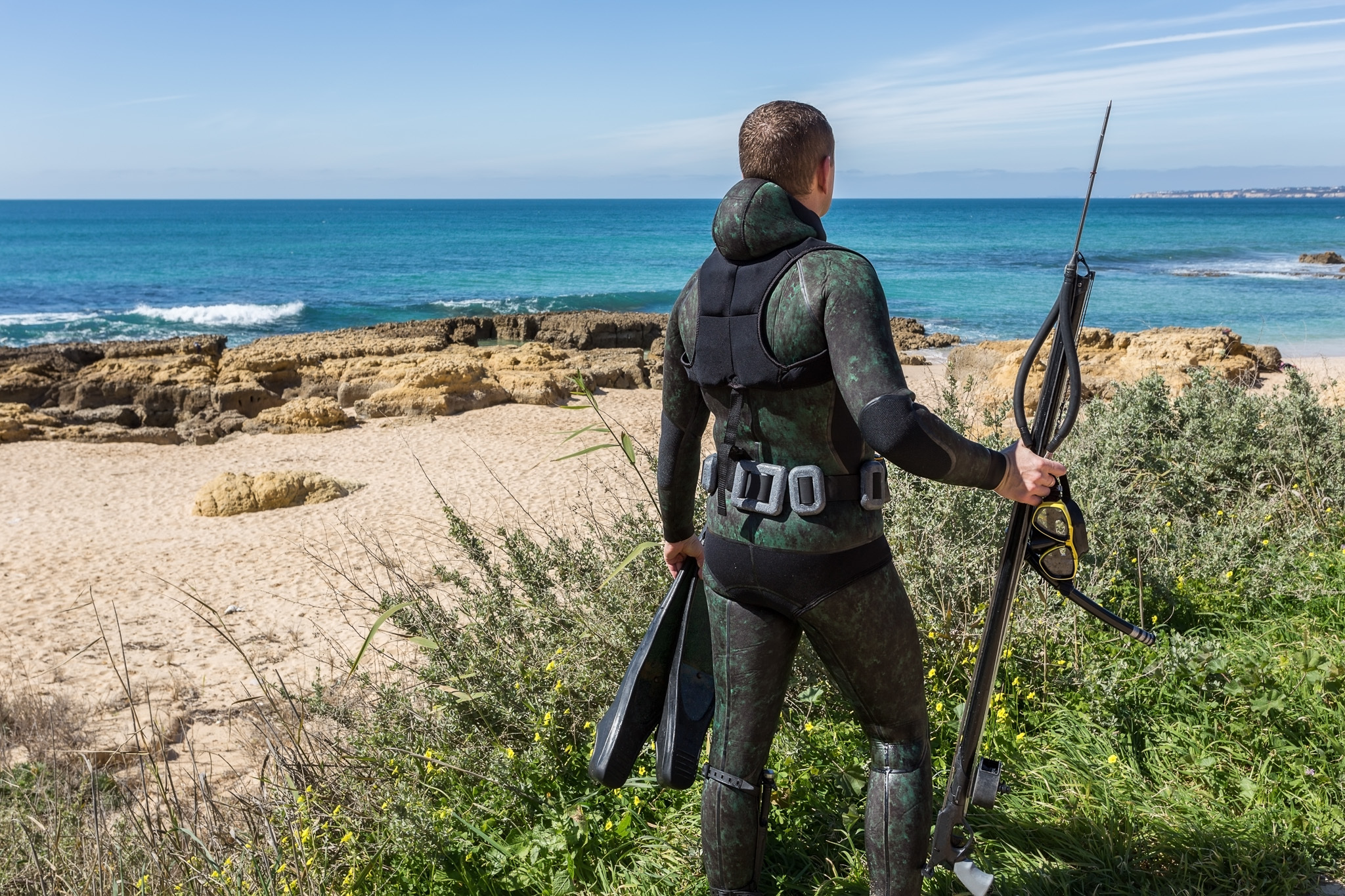
Although there are types of spearfishing that involve throwing a primitive spear while wading or on land, or spearing pike through the ice, this article will cover the most popular form of spearfishing that’s practiced around the world: swimming at the surface or underwater with a spear to kill fish.
Spearfishing is easy to try and if you get the opportunity to spearfish with a guide or an experienced spearfisherman, by all means — read this article and go. Just know that spearfishing quickly gets complicated when you factor in state and waterbody regulations, transportation by boat, spearfishing gear, diving certifications, hunting and spearing techniques, fish identification, safety concerns, and much more. We’ll cover essential spearfishing topics in this story to provide you with a solid foundation for the sport, and direct you to more resources.
For this article I interviewed three expert spearfishermen: two are experienced saltwater free divers in the Pacific (one of whom taught me to spearfish), and the third is a scuba diving instructor who spears invasive lionfish year-round in Florida. I also spoke with an intermediate diver about her first time spearfishing (she got attacked by an eel) to give rookies a perspective that will be closer to their own experience level.
Keep in mind that every state (and territory or country) has different spearfishing regulations with respect to gear, time of year, species, and bag limits, so be sure to read local regs before going. Your primary concern while spearfishing should always be safety. Dive with a buddy and know your limits.
Spearfishing Basics

You don’t need to have a competitive swimming background or a perfect freestyle to enjoy spearfishing, but you will need adequate swimming skills and a moderate comfort level in the water.
There are two primary methods of spearfishing: freediving and scuba diving. Since freediving is the preference of most serious spearfishermen for both ethical and practical reasons, that’s what we’ll focus on. Freediving is a good fit for shallow freshwater spearfishing (like in clear lakes and rivers) and for pelagic species, which are sensitive to the noise and vibrations of scuba equipment.
“Scuba equipment is loud,” says California-based spear fisherman and underwater cinematographer Mike Raabe. “It scares fish and turns you into an alien in the underwater environment. But free diving lets you become a part of the ocean. You’re able to observe, hiding in silence or interacting with animals naturally.”
Spearfishing is also becoming popular among scuba divers, however, mainly for targeting invasive species like lionfish. We’ll touch on that later.
Spearfishing Gear You’ll Need

In general you’ll want to make sure you have the following gear for spearfishing in fresh or saltwater.
Essentials
- Dive knife
- Fishing license
- Float and float line (attaches to your speargun)
- Speargun
- Snorkel and mask (properly fitted)
- Snorkeling fins and booties
- Swimsuit
Nice to Have
- Neoprene top or wetsuit (for warmth, concealment, and abrasion protection)
- Dive belt with lead weights (if you’re wearing neoprene, which is buoyant)
- Dive watch or waterproof sport watch
- Spare dive knife
- Stringer
Miscellaneous
- Cooler
- Fillet knife
- Ice
- Tube or creel, like a ZooKeeper, for invasive species
Types of Spearguns
Spearfishing spears are a lot like traditional bows: They come in many shapes and sizes, the nicer ones are handmade, and some are more powerful than others. Your experience level and the type of fish you’re pursuing will usually dictate the type of spear you want.
While the range of spearguns isn’t very far (a matter of feet or yards), it’s still a lethal weapon. Muzzle control is essential when spearfishing; never point your speargun at anyone in or out of the water. Always be sure of your target and what’s beyond it.
Pole Spear vs. Hawaiian Sling

This description of spear gun categories was written by spearfisherman Sam Ramono.
The simplest type of spear is a pole spear, and a good place to start if you want to buy your first speargun. The modern version consists of a fiberglass pole with a threaded tip, which allows different spear heads to be attached depending on the type of fish you’re targeting and the environment you’re fishing. Attached to the back of the pole spear is a band of surgical tubing. Cock the pole spear by stretching this rubber band forward and grasping the spear shaft. Then point the pole spear at the target and release the shaft, causing it to shoot forward. The Hawaiian sling is an improvement on the pole spear design, using a band attached to a tube. The tube is placed over the shaft, and the spearfisherman holds on to the tube and releases the spear. It acts like an underwater bow and arrow.
Spear Guns
Spear guns have a trigger and either a track or a barrel to guide the shaft along the length of the gun. There are two common versions: pneumatic guns, which use air pressure, and band guns, which use rubber bands made of heavy surgical tubing to propel the spear. Pneumatic guns are much quicker to load, but tend to lose power at greater depths. They are primarily used in freshwater lakes and shallow waters with limited visibility because of their lower power and generally smaller size. Band guns do not lose power regardless of depth, and they are the gun of choice for most spearfishermen. Bands are easy to replace, and these guns will shoot with only one band if necessary.

Spear guns come in a wide array of lengths, and it’s important to match the size of the spear gun to the visibility of the water you will be diving in. Longer guns offer an advantage in clearer water, where you can take farther shots. When the gun is longer, the tip of the spear starts much closer to the target. In water with limited visibility, however, a long gun is a huge disadvantage. You don’t want the tip of the gun to reach beyond your visibility. Plus, a longer gun is also much harder to swing on moving fish.
Shafts, Lines, and Reels
Spear shafts are generally made of spring steel to help prevent bending, and they come in a variety of thicknesses. Spears can either be free shafted (no line attached at all), attached directly to the spear gun with a line (Spectra, heavy monofilament, or braided steel cable), attached to a reel mounted to the spear gun, or attached to a float rig that prevents the fish dragging it underwater and allows the diver to retrieve both the fish and the spear.
Spear Tips
Here’s where a good local dive shop is invaluable. They can help recommend the best shaft, tip, and method of shaft attachment for any given spearfishing situation (especially for waters in your area). The right recommendations will save you both time and money spent learning which gear works (or doesn’t work) the hard way. — Sam Romano
Floppers
Most spear tips have an extra piece of metal on the tip called a flopper, which essentially functions like a barb on a fishing hook. It’s designed to keep thrashing fish from flopping off your spear, though the flopper can certainly fall off, especially with cheaper equipment and if you spear bigger, more aggressive fish.
Freediving
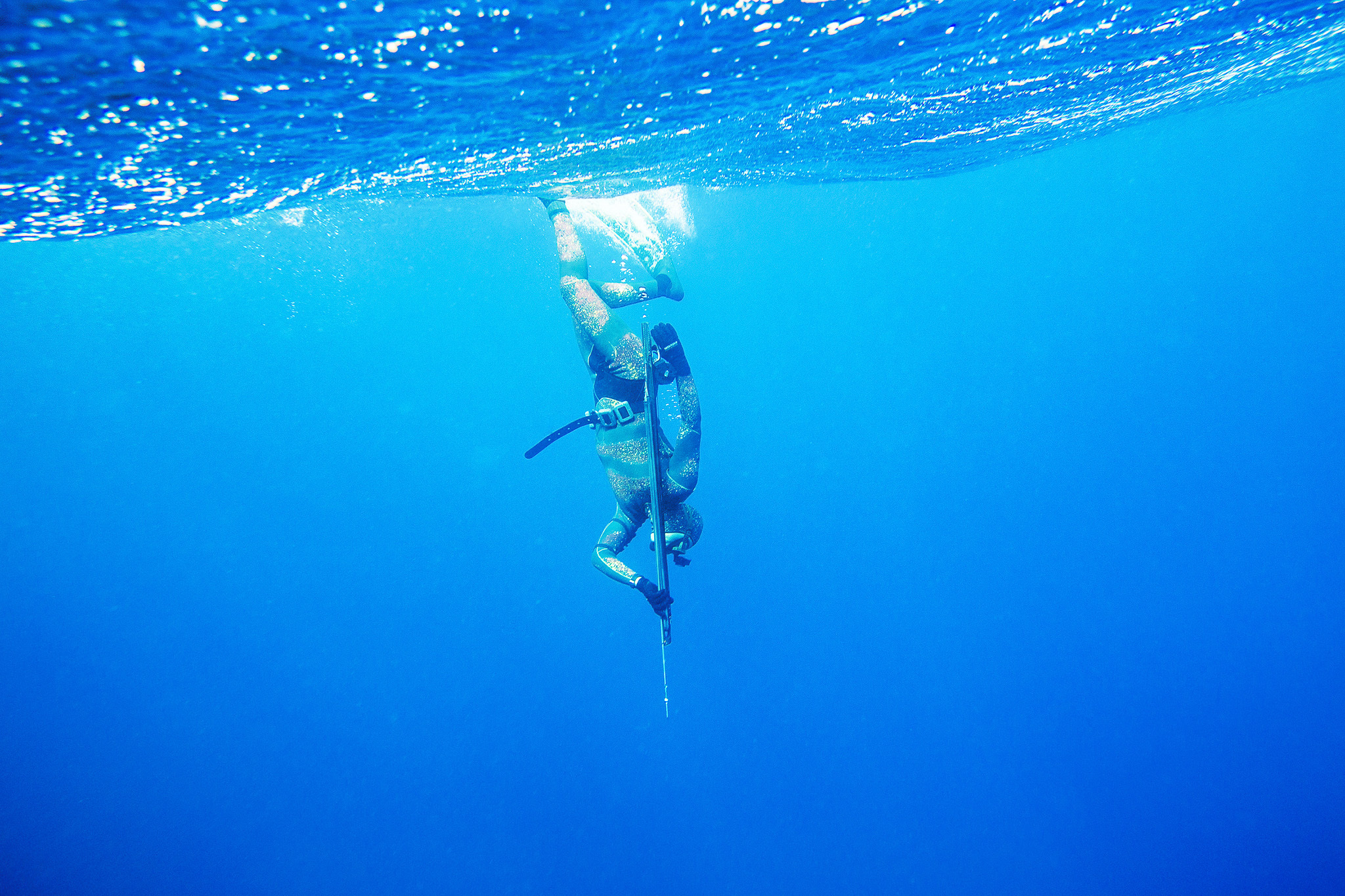
Most spearfishermen practice freediving. In the simplest terms, free divers wearing snorkels go underwater and return to the surface on a single breath. Free diving is straightforward, easy to practice at home (seriously), and it requires little gear and no formal training for beginner spearfishermen.
Static vs. Dynamic Breath Holds
A major factor in your spearfishing success will be your ability to hold your breath. You can improve your lung capacity with proper breathing techniques and experience.
“It’s about learning how to breathe with your diaphragm,” says Aidan Mooney, a 19-year-old San Diego native who has been spearfishing since he was 13. “When you learn to control your heart rate through that breathing process, that allows you to control your oxygen levels. You end up feeling so much more comfortable spearfishing if you know how that technique works. People can hold their breath a lot longer than they think just by learning the proper technique.”
Even if you think you’ve got pretty good lung capacity — maybe you can hold your breath for a minute or two in the swimming pool — you’ll discover it’s greatly reduced while spearfishing. That’s the static vs dynamic breath hold phenomenon. A static hold just means holding your breath while doing nothing. A dynamic hold involves holding your breath while actively swimming.
The rule taught in most freediving courses is to divide your static breath hold in half. That’s how long you’ll be able to hold it while spearfishing. For instance Raabe, the cinematographer and spearfisherman, can hold his breath for five minutes if he’s staying still (his static breath hold). Theoretically, he should be able to dive for two minutes and 30 seconds (his dynamic breath hold) while spearfishing.
“But I’ve never done a 2 minute and 30 second dive,” says Raabe, who has been spearfishing since 2005 and dives roughly 60 days each year. “Two minutes is my max, and a minute and 30 seconds is a good average dive. Say I’m diving for sea bass and I’m just checking an area out, I might do a bunch of one minute dives. And then when I see a fish or I hear [a seabass] croaking, then I’m going to slow down, take my time, and do a minute and a half dive, which I can push to an extra 10, 20, 30 seconds if I know it’s happening and I need to stay down there as long as I can [to spear the fish].”
How to Hold Your Breath Underwater
You can find more detailed instructions for practicing your static breath hold here. But the key is to begin with short breath holds (around 20 to 30 seconds) and gradually increase them as you get more comfortable.
“Practice sitting on your couch,” says Mooney. “It’s one of the best ways to test yourself. I used to do static breath holds while I was getting into freediving and I’d get up to 3 minutes and 30 seconds on the couch.”
After each long breath hold, you should always practice recovery breaths. These help re-oxygenate your body and prepare you for the next dive. Never dive while hyperventilating, which just means breathing abnormally fast. (You can see a short example of Mooney free diving in the video above.)
“I have a dive watch that has a surface interval timer on it,” says Raabe. “When I get to the surface, it vibrates after two minutes. So every two minutes I’m trying to make a dive. The rule of thumb when you take a freediving class is, if you want to make a two minute dive you should do a breath up [inhaling at the surface] for four minutes. I don’t necessarily do that, but the two minute timer is a good pacing thing to keep me [safely] diving as much as I can.”
Freediving Classes
If you plan to spearfish more than once or twice, consider taking a freediving certification class. Not only will it help you maximize your dives while spearfishing, it will teach you about the risks of freediving, including shallow water blackouts (more on that later). Certifications aren’t usually required but they can give you peace of mind as you start to push your physical limits while spearfishing. Many different types of freediving courses are available with e-learning and in-person components, including through:
Spearfishing from the Surface
Unless you’re already a freediver, you’re likely going to struggle with holding your breath and diving deep while spearfishing. Fortunately there are opportunities to spear many species of fish close to the surface. In certain freshwater areas, like the San Marcos River in Texas, you can stay just a foot or two below the surface while spearing invasive suckermouth catfish.

My first time spearfishing, I dropped into a school of dorado with Mooney. We were 18 miles off the coast of California in the open water of the Pacific. I was wearing a snorkel and fins for the first time since I was eight, and I was seasick. I had practiced my static breath hold for weeks ahead of our trip, but found that the ocean current, the act of treading water, and my adrenaline made staying underwater longer than 30 seconds impossible. I also didn’t have a dive belt with weights on, and I kept floating toward the surface in my neoprene. Fortunately, dorado were schooling close enough to the surface that I could watch the fish, take frequent breaths, and look for the opening I needed to shoot one. After I shot my fish, I watched Mooney swim straight down into the gloom beneath me to locate and shoot a yellowtail, which were hanging at a lower depth, then safely return to the surface.
Locating Fish for Spearfishing
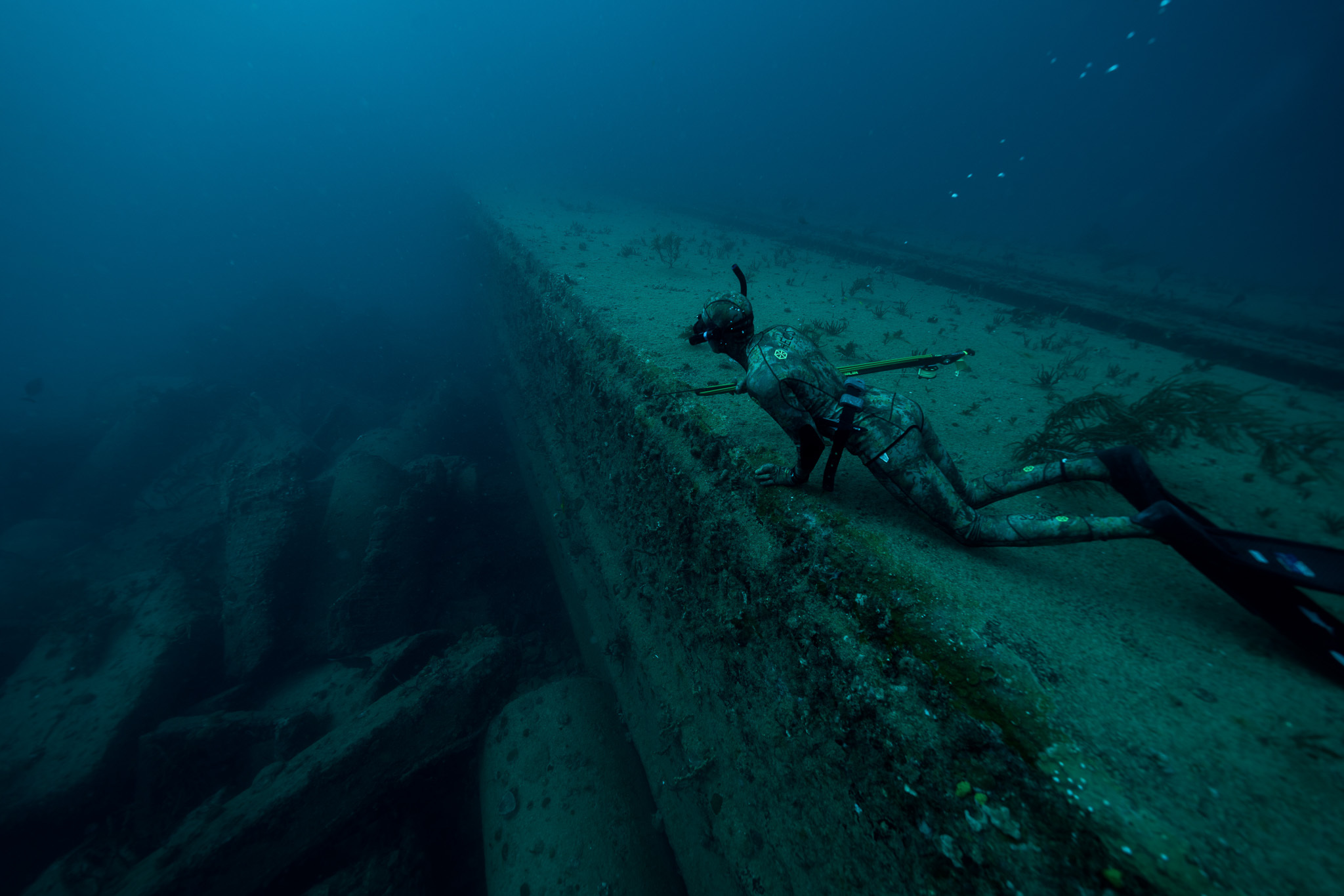
To spear fish, you need to find them first. The best way to go about this will vary based on where you’re fishing. Scouting for offshore species is time intensive and requires experience and access to a boat and electronics. If you’ve got your heart set on spearing pelagic species like dorado or yellowtail, your best bet is to tag along with someone or hire a spearfishing guide.
If you’re determined to find fish on your own, keep in mind that fish of all kinds tend to congregate around structure like rocks, reefs, and other manmade structures like wrecks. Keep a sharp eye out for seabirds and disturbed surface water, and don’t be afraid to use fish finders. Pelagic fish like dorado, yellowtail, yellowfin, and bluefin can be found schooling near kelp paddies.
If you’re landlocked and looking to try spearfishing in freshwater, contact your local state game agency for advice on which fish are in season and where to find them. For instance, spearfishing is now legal in Michigan with in-season take allowed for walleye, northern pike, lake trout, and other species.
Spearfishing Techniques
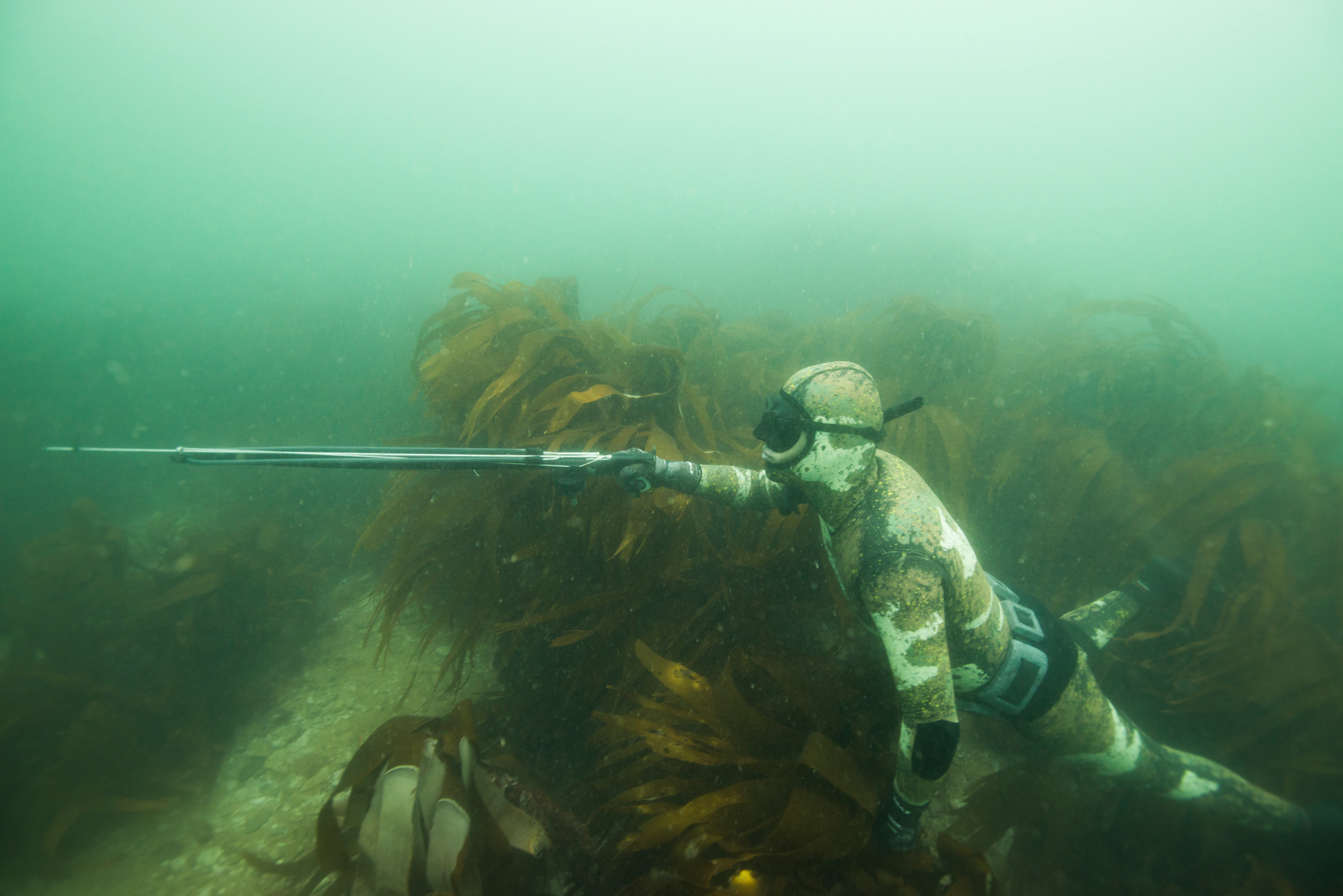
Just like hunters, different spearfishermen have different tactics for how they hunt, even when they’re pursuing the same species. The way a big game spearfisherman targets tuna is going to look different from a reef spearfisherman who is targeting, say, grouper hiding under a rock. Still, there are a few universal approaches to spearfishing, which generally require stealth (and sometimes concealment), patience, and smart shot selection.
Hunting Fish
When Mooney spots a boil of fish offshore, he and his dad (his go-to diving buddy) fly the dive flag while he pulls on his wetsuit then loads his gun.
“I’m going to hop in the water and look around with my eyes. I don’t want to move my body too much. And I’m not going to try to make eye contact with fish if I see them. I’m going to look away from the fish and curl up in a little ball and look as small as I can possibly be. I’m going to try to attract the fish to me and make them wonder what I am, and have them swim up to me. Sometimes you’ll see me doing a little squid motion with my fingers, and that’ll attract fish. That brings yellowtail in, dorado, even tuna, wahoo — it can work on a lot of offshore species.”
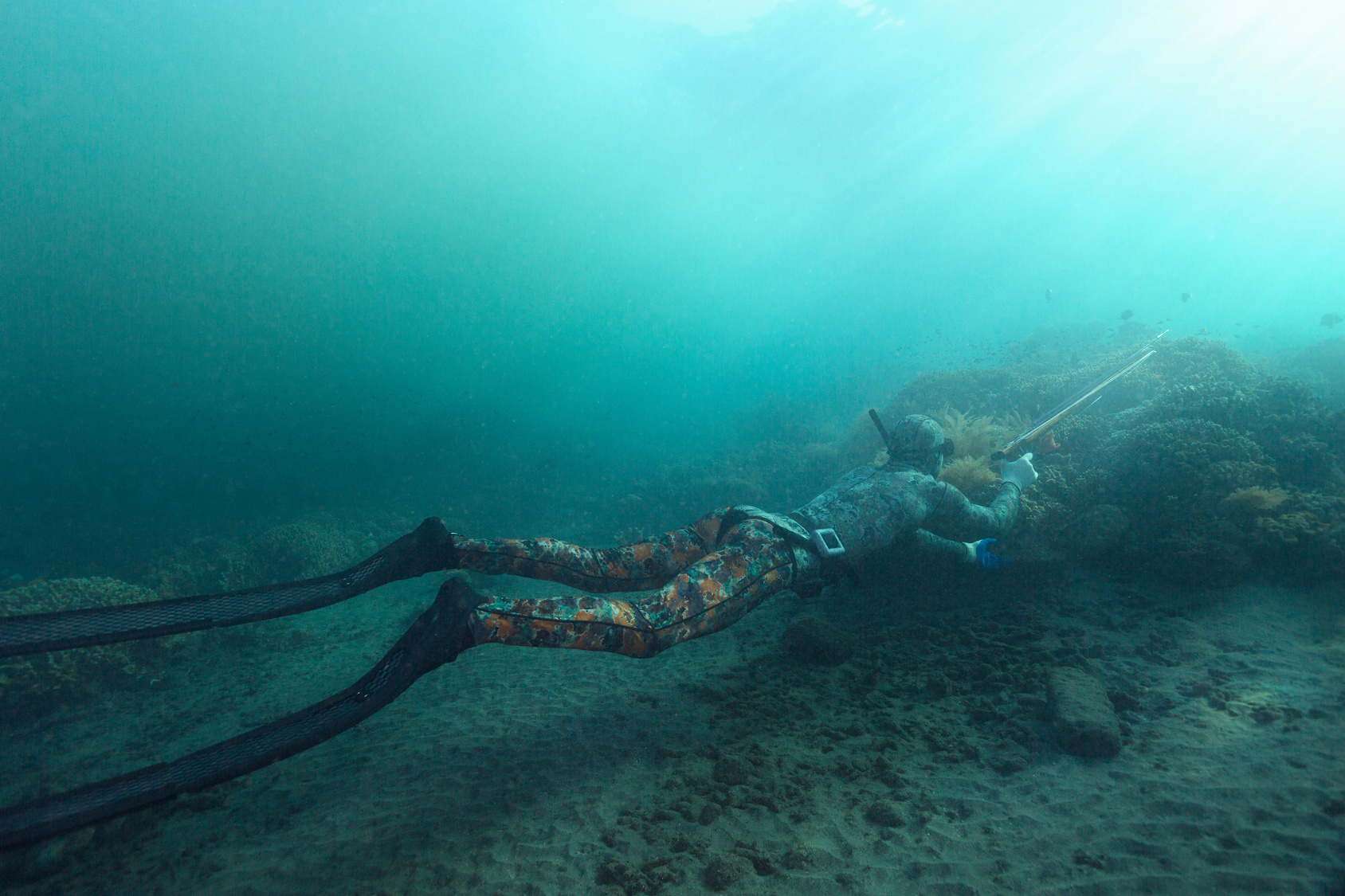
Other fish are more difficult to hunt, requiring extreme stealth and concealment in your environment. White seabass, which are Raabe’s favorite fish to pursue, are notoriously difficult to locate and kill among the kelp beds of SoCal. Visual concealment — usually achieved with a camouflage wetsuit, cautious movement, and by sticking to shadowy kelp for cover — is just one thing spearfishermen like Raabe have to keep in mind when chasing white seabass. Because the fish can both hear noise and feel vibrations thanks to their lateral lines, divers must take care not to, say, bump their speargun on the bottom while listening for croaks (seabass are part of the croaker family). Even bubble control when exhaling is key — and don’t even think about farting in your wetsuit. (You can see more photos of Raabe spearfishing for white seabass here.)

Meanwhile, dorado are relatively easy to shoot since they don’t spook easily. Mooney’s advice for spearing dorado is simple: When they get close enough, shoot them in the eye.
“I’ll dive down to the school, whether it’s 10 or 20 feet,” says Mooney. “The main thing is you want to get level with the school of fish so you can get a broadside shot, just like when you’re hunting. I’ll get level and let my gun extend out straight, I’ll point it at a school, and wait for a fish to swim into my line of sight, [then pull the trigger].”
Aiming
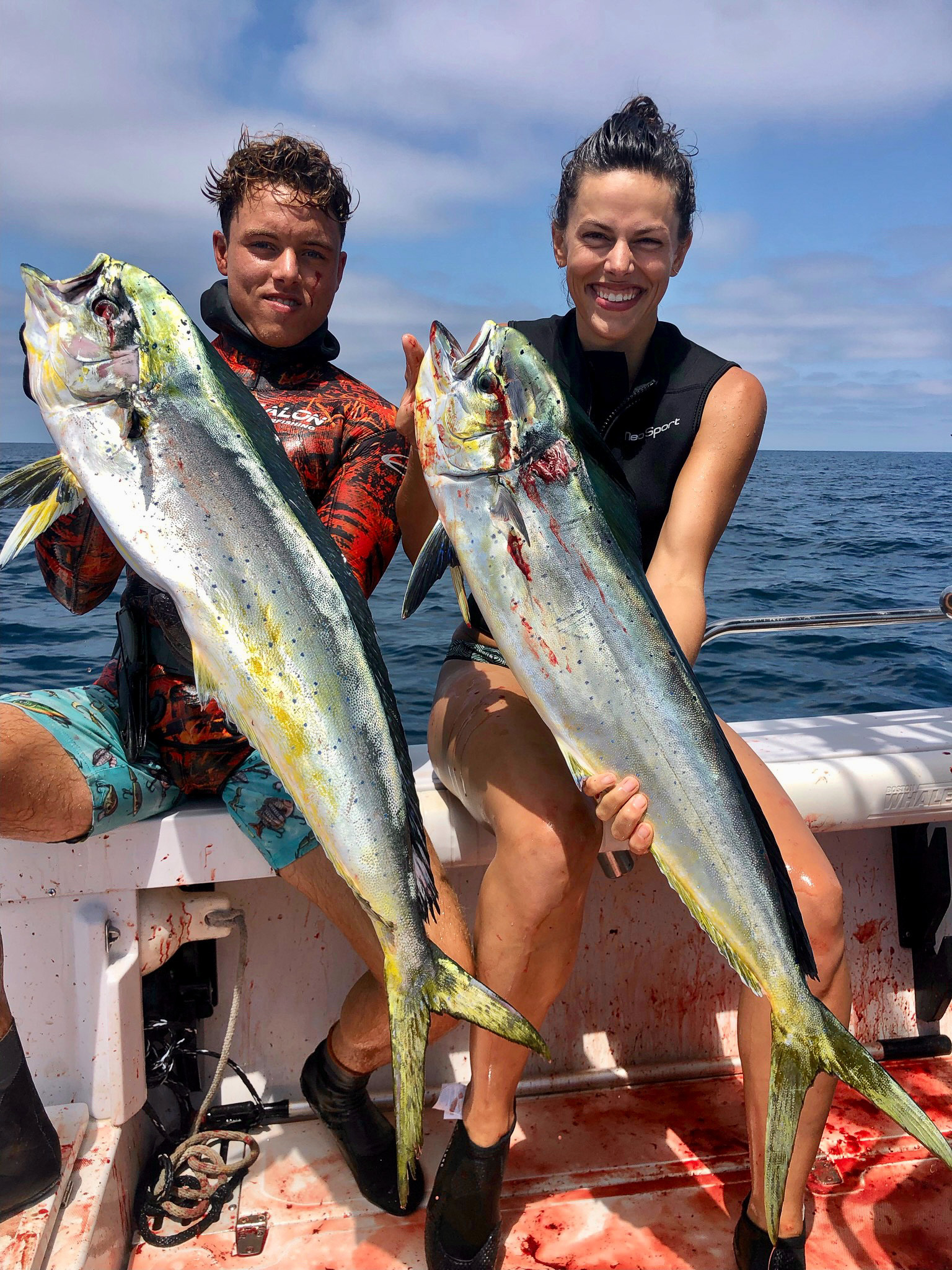
The range of most spearguns is surprisingly close. For a pole spear, says Raabe, that’s about five feet, or essentially a couple feet less than the length of the polespear. For larger spear guns, your range might be anywhere from 10 to 20 or more feet. Mooney uses a custom built roller speargun that he’s comfortable shooting at fish 5 to 10 feet away, with a maximum effective range of about 15 feet.
Mooney’s goal is to shoot fish in the eye, which means he’s usually leading the fish as he would a crossing clay target with a shotgun.
“I’m aiming for their nose,” Mooney says of species like dorado and yellowtail. “You have to lead 2 to 3 inches usually. Because right when a fish notices you’ve shot, it’ll freak out and move as quickly as possible. Just like a deer would duck [the bowstring], fish do the same thing. If you’re going to shoot something much bigger like a tuna, you’ll want a much bigger lead.”
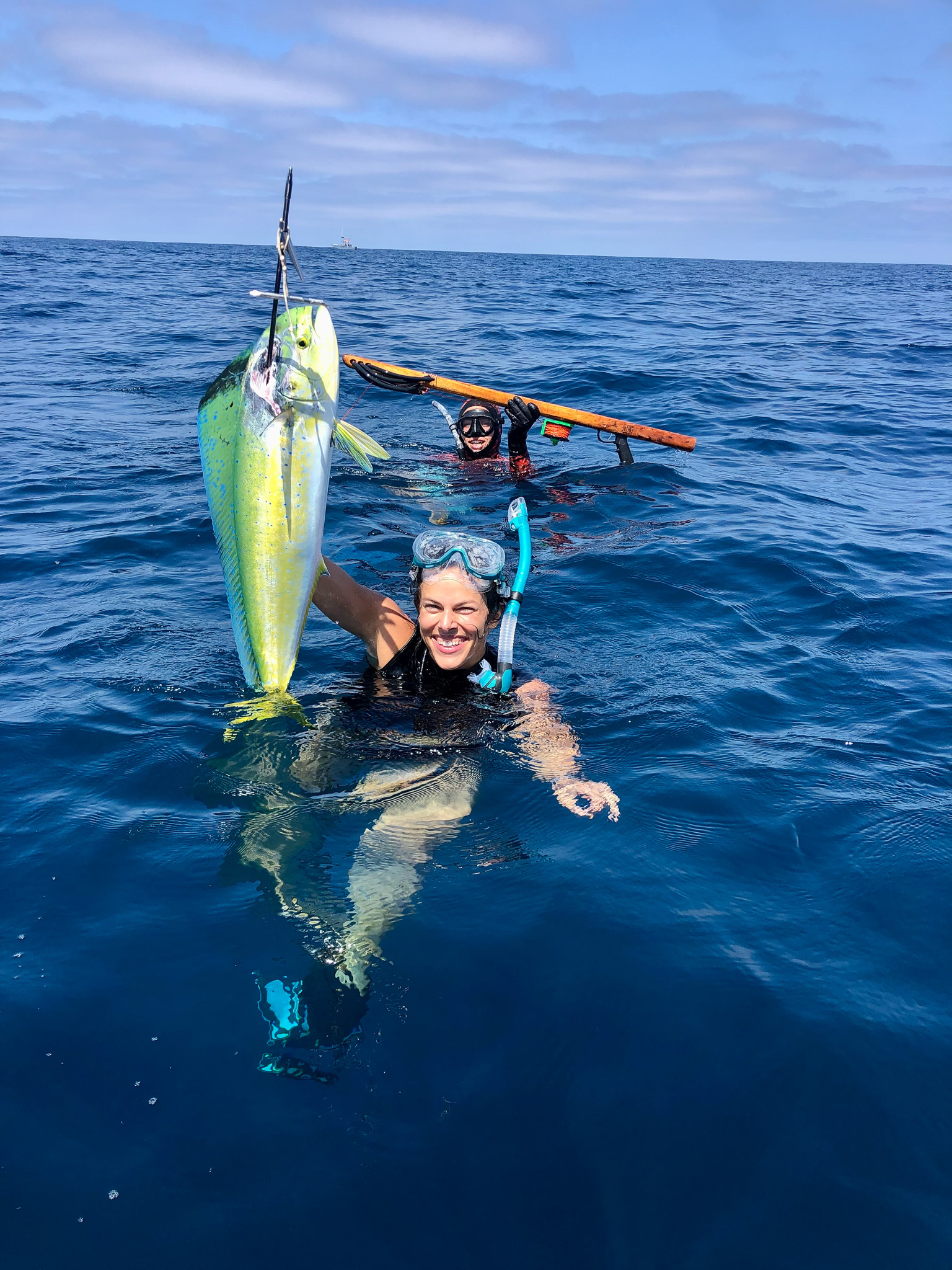
If you can maneuver the tip of your spear close to a calm fish that isn’t swimming (say, 6 inches from a lionfish), you won’t need to lead it. Just aim and fire.
Recovering and Caring for Fish
When you shoot a fish, be prepared for it to thrash around. The key is to get your hands on the fish quickly to prevent losing it and to avoid getting tangled in your line if you’re using one. With big game fish you may need to tap in a buddy or swim to the surface and hang onto the line and fight fish between breaths. In certain cases, you may need a buddy to shoot a fish a second time to anchor it.
When shooting smaller fish with a pole spear, recovery is more straightforward.
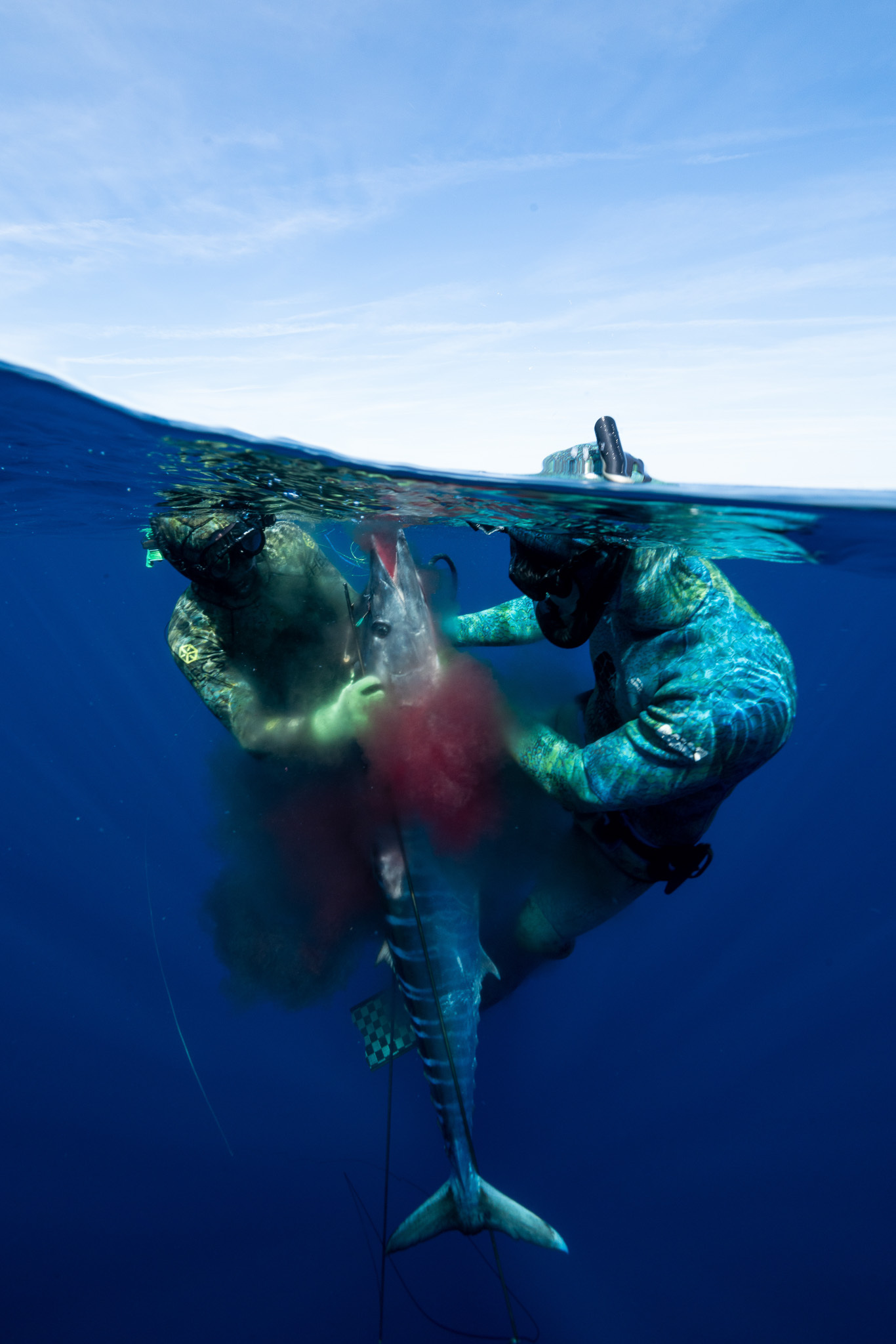
“You want to put your hand on either side of the fish on the pole spear to secure it in case the flopper [mechanism] comes down, because then fish could slide off,” says Raabe. “You’re going to come to the surface with it and try to get your hands in the gills as quickly as you can. Then I like to brain the fish first and then take my dive knife and slide it down the gills to bleed it.”
To brain the fish, Raabe inserts his knife between the eye and dorsal fin. To bleed it, he cuts between the gills and the body side of the fish, as demonstrated in the video below.
“Bleeding is very important for the quality of meat,” says Raabe. “Even with little fish it makes a difference. Seabass, yellowtail, halibut, even calico — I bleed all those. And I gut them as quickly as I can too.”
Once you’ve bled your fish, you can either attach it to a stringer on your float or, in the case of bigger fish, return them to your boat and get them on ice.

Is Spearfishing Dangerous?
Spearfishing is risky for all kinds of reasons, most of which are related to the usual hazards of swimming in open water. Drowning is the primary concern for divers of all skill levels.
“Everybody’s scared about sharks and it’s not as big of an issue,” says Raabe. “Obviously it’s something you should be conscious of, but there aren’t great whites everywhere that will come eat you. The most dangerous stuff is entanglement in your gear when you shoot a fish, and shallow water blackout. Most of the drowning accidents that happen are never on the bottom, it’s people coming back to the surface who are weighted too heavily and don’t make it back.”
Shallow Water Blackout
Shallow water blackout usually occurs when a spear fisherman is returning to the surface but passes out from lack of oxygen before reaching it — usually at a depth of 15 feet or less. There aren’t exact stats on how common it is, but there’s usually a news story every year about a U.S. spear fisherman or free diver who likely drowned this way.
“I never push my limit when I’m diving. There’s no reason. I’m never going to die over a fish,” says Raabe. “When you’re learning, you don’t understand your limits, and that can be a problem. As you hold your breath longer – hurting isn’t the right word but you don’t feel comfortable, and you have to learn that discomfort is the buildup of Co2 in your lungs, not the lack of oxygen. So you can learn to push it. But if you push it too much, and you come to the surface and your lips are blue and you’re hypoxic, you could samba — which is like you’re shaking — you can pass out and drown on the surface.”
“I never push my limit when I’m diving. There’s no reason. I’m never going to die over a fish.”
—Mike Raabe
According to the National Library of Medicine, shallow water blackout “most commonly involves males under the age of 40 and has a high fatality rate. Of note, in a CDC case series, 13 of the 16 dangerous breath-holding cases identified in New York were males. Of the 16 cases, four resulted in a fatality … The average person can hold their breath for between 30 to 90 seconds. It is very rare for people to be able to hold their breath for much longer without specialized training or preparation. Those most at risk for hypoxic blackouts are novice divers going to moderate depths.”
When diving to depths below 50 feet, Raabe always follows the buddy system.
“When you’re doing 100-foot drops you should be diving with someone and they watch you come to the surface. And if that happens, your buddy grabs you and brings you to the surface and shakes you — and a lot of times you wake up. You can also be trained to do rescue breaths, stuff like that. But don’t put yourself in that position.”
Do Free Divers Get the Bends?
While free divers aren’t usually at risk for the bends, free diving experts recommend mandatory surface time between dives, usually proportional to the duration of the dive. For depths of 25 meters or less, that’s double the dive (so three minutes for every 1.5-minute dive, with a 15-minute break every 1.5 hours).
Scuba divers, however, must carefully control their ascent to the surface to prevent decompression sickness while spearfishing. There are other scuba-related medical concerns, all of which are covered in mandatory scuba diving certification classes.
Entanglement

Besides carefully timing his dives, the second big safety precaution Raabe takes is always carrying a dive knife. He primarily uses it to bleed fish to keep the meat tasting its best, but his dive knife pulls double-duty in a spearfishing emergency. Once he shoots a fish, especially a big, hard fighting pelagic species, there’s always a risk of getting tangled in his own line. Raabe only uses a Riffe dual-serrated dive knife.
“Most dive knives are serrated on just one side and the blade side doesn’t necessarily cut through the rope or cables. With the double serrated, you don’t have to even look at the knife — you just pull it out and cut the line without thinking about it,” says Raabe. “When we tuna hunt, we use steel cable for our shooting line, and when there’s tension on it, you can cut it. When there’s no tension on it, you can’t cut it. But if you are going to cut it, you want that double-serrated knife.”
Raabe, who is right handed, also keeps his dive knife on his right hip — never his leg, as many spearfishermen do. Your non-dominant bicep is also a fine place to keep a knife or a backup knife.
“Say you’re spearfishing tuna and you shoot a tuna, it goes berserk, it does a 360 around you, your line gets caught around your ankle, and it starts pulling you down. Now you have to bring your arms and torso down [to reach your knife on your leg] as you’re being pulled down like that. That’s not necessarily something you can do. But your hand can always reach your hip.”
Sharks and Other Animal Attacks
Although sharks have been known to attack spearfishermen, shark attacks that result in injury are extremely rare, and spearfishermen make up a fraction of those attacks. Encounters are much more likely; spearfishermen hunt where the fish are, and so do sharks.
Before I entered the water to spearfish dorado with Mooney, he had spotted a “big mako or a small great white” shark in the kelp paddy. His advice, and Raabe’s, is to never turn your back on a shark if you encounter one. “It’s the sharks you don’t see that you have to worry about,” says Raabe. If a shark does attack, do whatever you have to to fight it off, include shooting it (like in this video below) or using your hands and your dive knife if you’ve already deployed your spear.

Emily Krebs is an intermediate scuba diver with 36 dives already in 2024 (and she happens to be my sister). She’s never had issues with aggressive marine life before trying spearfishing for the first time this month. Shortly after shooting two lionfish off a reef in Honduras, she saw a 6-foot-long green moray eel emerge from the rocks and beeline for her dive master, who was holding her lionfish in a tube.
“I screamed into my regulator and he whipped around and saw the eel coming for the lionfish. We were kicking our fins at it and I was waving my pole spear in the eel’s face — I was trying to scare it off but not hurt it — and it wasn’t backing off.”
The instructor grabbed her spear and ended up jabbing the eel in the head repeatedly until it retreated, though not before rushing another diver nearby. This video is similar to her experience.

Apart from immediate bodily harm, one of the key concerns in both these scenarios is that a territorial shark or aggressive eel can distract you during your dive. Maybe you get tangled in your line, or you lose track of your dive time, or — in the case of a scuba diver — you ascend too quickly while attempting to escape, resulting in the bends.
For his part, Raabe worries more about sea lions than sharks, which are massive (bulls can top out at 1,000 pounds) and abundant where he dives in SoCal. One particularly aggressive bull once had Raabe and a buddy back to back trying to protect themselves, and his buddy had to jab it in the neck with the spear in order to scare it off.

Scuba Diving and Spearfishing Lionfish
Scuba diving is expensive, requires certification and lots of gear, and generally isn’t considered sporting or effective for hunting spooky pelagic fish. But if you already know how to scuba dive and you’re interested in spearfishing, lionfish spearing is a good place to start since they’re an invasive scourge in the Atlantic and Caribbean. Removing lionfish is good for native critters and ailing reefs, and lionfish taste great. Plus, it’s just fun.
“We love spearing lionfish,” says Tim Robinson, a scuba instructor who goes spearfishing with his sons year-round in Florida. “It’s the thrill of the hunt. They’re not just out swimming around freely. In most cases, you have to hunt for them.”
Read Next: Photos from the World’s Biggest Lionfish Derby
Robinson is an instructor who teaches lionfish spearfishing classes, and he also owns ZooKeeper, which makes a sort of underwater creel for safely storing venomous lionfish during dives. In addition to the ZooKeeper and all the scuba gear, Robinson recommends carrying a bright dive live since lionfish hide beneath ledges or in holes in the reef.
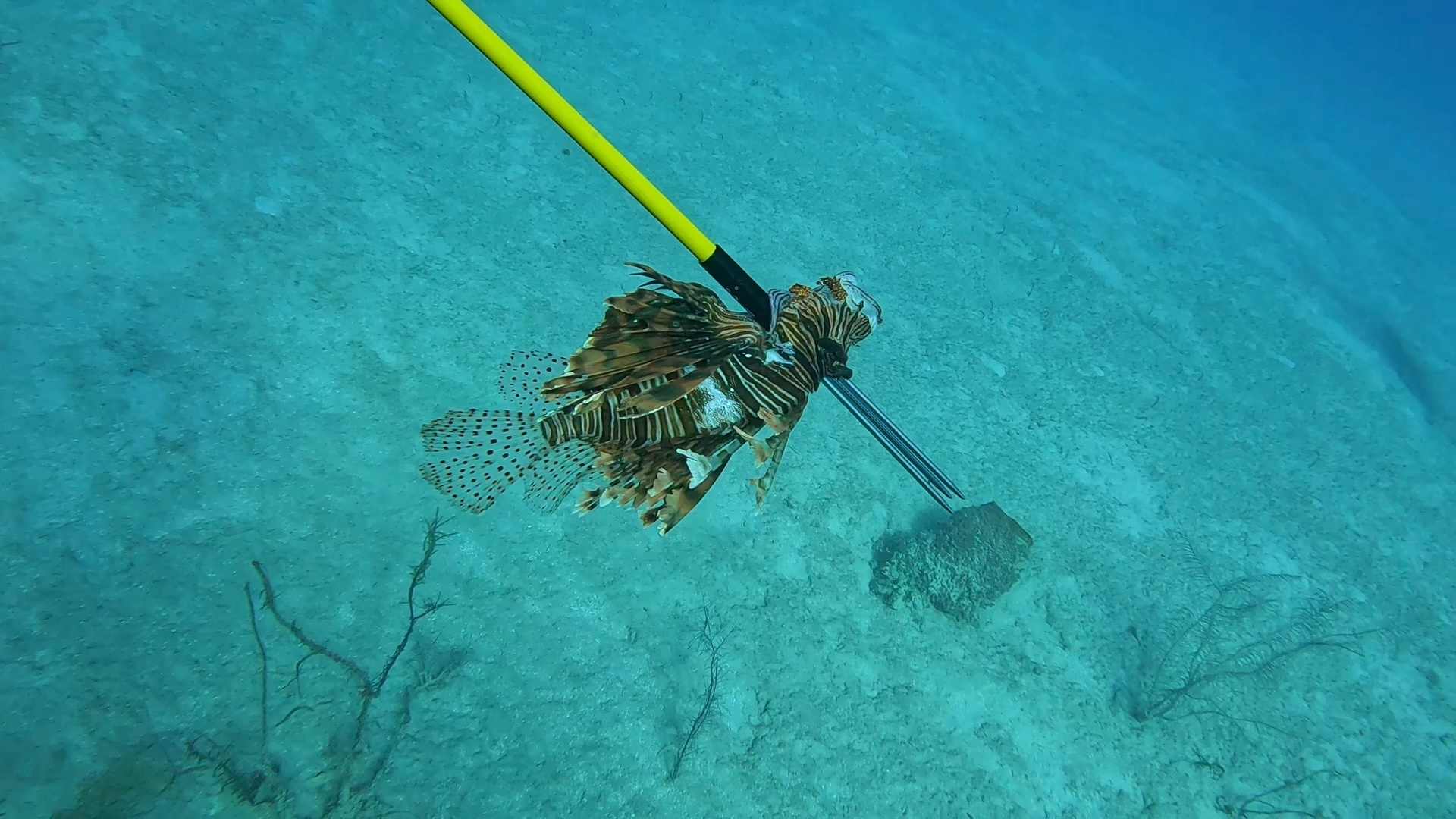
“They can blend in with whatever they’re around,” says Robinson. “I always say to think like a lionfish. Like if I were a lionfish, where would I be? Typically that’s under a ledge. They actually invert themselves and go belly up underneath one. Half the fish I shoot are upside down.”
Lionfish don’t have natural predators in U.S. waters, which is why they’re so easy to approach and shoot. The key is to ensure you take shots that don’t strike the reef.
“We’re trying to protect the reef from the lionfish,” says Robinson, who never wants his spear to pass through a fish and strike a reef. Careful shot placement is key. “You basically swim right up to a lionfish. You can actually touch them with your spear and maneuver them around a little bit. Because they don’t have a predator [here], they’re not afraid of you. As a general rule, they’ll let you come right up to them and put the spear within a couple inches before you shoot them.”

Apart from fending off the eel, Krebs says spearing lionfish at 6 inches was shockingly easy (see the video clip above). She advises getting enough scuba dives under your belt before trying to incorporate spearfishing: “Make sure you have good buoyancy control before you decide to start spearing lionfish so you don’t hurt the reef by running into it.”
If you’re interested in learning to scuba dive, you can sign up for your PADI Open Water Certification, which is the first level of scuba certification.
FAQs
Yes, spearfishing is legal in many places in the U.S. with the usual fisheries management restrictions on species, seasons, bag limits, equipment, and waters. Hawaii, California, and Florida are all popular destinations for spearfishing in the U.S., but regulations differ in each state. For instance, it’s illegal to spear freshwater in Florida, as well as to spear many of the state’s popular saltwater gamefish (billfish, snook, tarpon, etc.) or any ornamental reef fish.
Regulated spearfishing is an ethical way to obtain fresh fish and to remove invasive species. Unless a speared fish flops off the end of your spear (it happens), there is no catch-and-release in spearfishing. That means most spearfishermen are either spearing game fish they plan to eat or they’re attempting to remove invasive species that harm native critters and ecosystems. The bottomline: As long as you don’t spear more than you eat, you respect marine life and the reefs, and you stay legal, freedive spearfishing is perfectly ethical.
There is a long-standing position in the diving community that spearfishing with scuba equipment is unethical because of the huge advantage it lends humans, allowing us to dive for long periods and swim close to critters who’ve evolved without a natural fear of humans. Spearfishing for damaging invasive species like lionfish with scuba equipment, however, is perfectly ethical; the goal is to maximize lionfish removal, and scuba gear lets spearfishermen dive deeper for longer.
Spearfishermen who practice freediving hold their breath underwater, wearing only a snorkel and taking deep recovery breaths when they surface. You can use scuba equipment to breathe underwater and dive for longer periods at a time, but regulators are noisy and produce bubbles, and often disturb the sensitive pelagic fish you plan to spear.
Many spearfishermen would say the hardest fish to spearfish is the white seabass, a member of the croaker family that’s targeted in kelp paddies off the coast of Southern California. You can read more about why the Gray Ghost is so difficult to hunt here.
Yes, in most places in the U.S. you will need a recreational fishing license to spearfish. There may be exceptions for invasive species, though not always. For instance, you do not need a fishing license to spear lionfish in Florida, but you need a special license to spear the same exact species in Honduras.
It depends on the individual, but an experienced spearfisherman can hold their breath for one to two minutes while actively spearfishing. Many spearfishermen are capable of holding their breath for much longer (up to five minutes) when not moving and simply observing fish underwater. The longest static breath hold on record was an astounding 24 minutes and 37 seconds, set by a Croatian freediver in 2021.
In general, yes, you should fly a dive flag while spearfishing in open water. Even if a dive flag is not legally required while spearfishing (check your state’s fishing and boating regulations) it’s a good idea to display a dive flag on your speargun float or your vessel to warn boaters there are swimmers in the water.
Final Thoughts
Spearfishing might seem intimidating, but it’s surprisingly easy to get started with a minimal amount of gear and enough motivation — even if you don’t live near the ocean. As long as you’re disciplined about your gear and your techniques, and you’re willing to stay within your physical limits, you’ll find that spearfishing is the ultimate test of physical and mental endurance, and some of the most fun you’ll ever have fishing.


